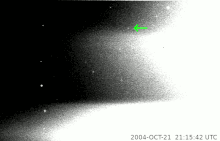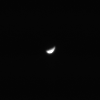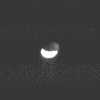Polydeuces (moon)
 Polydeuces imaged approximately 73,000 km (45,000 mi) away from theCassinispacecraft on 22 May 2006 | |
| Discovery[1][2] | |
|---|---|
| Discovered by | CassiniImaging Science Team[a] |
| Discovery date | 21 October 2004 (date of discovery images)[4]: 223 |
| Designations | |
Designation | Saturn XXXIV |
| Pronunciation | /ˌpɒlɪˈdjuːsiːz/[5] |
Named after | ΠολυδεύκηςPolydeykēs |
| S/2004 S 5 | |
| Adjectives | Polydeucean/ˌpɒlɪdjuːˈsiːən/[6] Polydeucian/ˌpɒlɪˈdjuːsiən/[7] |
| Orbital characteristics [8][9]: 9 | |
| Epoch1 January 2000 12:00 UT (JD2451545.0) | |
| Earliestprecoverydate | 2 April 2004[10]: 695, 702 [11]: 261 |
| 377600km | |
| Eccentricity | 0.019 |
| 2.736916d[8] | |
Averageorbital speed | 10.03 km/s[12]: 2 |
| Inclination | 0.2°[b] |
| Satellite of | Saturn |
| Group | L5Dione trojan |
| Physical characteristics | |
| Dimensions | 3.50 × 3.10 × 2.62km (±0.40 × 0.40 × 0.40km)[13]: 7 |
| 3.06±0.40 km[13]: 7 | |
| Volume | 15 km3[c] |
| Mass | ≈ 8×1012kg(assumed; unmeasured)[d] |
Meandensity | ≈ 0.5 g/cm3(assumed; unmeasured)[14][15]: 3 [12]: 2 |
| ≈ 0.0002 m/s2at longest axis to ≈ 0.0003 m/s2at poles[e] | |
| ≈ 0.0008 km/s at longest axis to ≈ 0.0009 km/s at poles[f] | |
| assumed synchronous[12]: 4 | |
Polydeuces/ˌpɒlɪˈdjuːsiːz/,also designatedSaturn XXXIV,is a smalltrojanmoon of Saturnoccupying the trailingL5Lagrange pointofDione.It was discovered by the Cassini Imaging Science Team in images taken by theCassinispace probeon 21 October 2004. With amean diameterof about 3 km (1.9 mi), Polydeuces is thought to have a smooth surface coated with fine, icy particles accumulated from thecryovolcanicplumes ofEnceladus.In its orbit around Saturn, Polydeuces periodically drifts away from Dione's Lagrange point due to gravitationalperturbationsby other nearby moons of Saturn. Of the four known trojan moons of Saturn, Polydeuces exhibits the largest displacement from its Lagrange point.
Discovery[edit]

Polydeuces was discovered by the Cassini Imaging Science Team[a]on 24 October 2004 while routinely investigating images taken by theCassinispace probeearlier on 21 October 2004.[4]: 223 The images were visually inspected through theblink comparisontechnique, which revealed any potential moons that moved relative to the background stars. The discovery images consisted of four frames taken withCassini's wide-angle camera over less than six minutes, which showed Polydeuces moving 3–6 pixels per frame.[g][4]: 223 The observed motion of Polydeuces immediately suggested that it could be orbiting Saturn at the distance of one of the large moons,Dione,possibly sharing its orbit in aco-orbital configuration.[4]: 223
By 4 November 2004, the Cassini Imaging Science Team obtained moreCassiniimages of Polydeuces, including two frames taken on 2 November 2004 and another two predating the discovery images by three hours.[4]: 223–226 Preliminaryorbit determinationsusing these images confirmed that Polydeuces was a co-orbitaltrojan moonresiding around Dione'sL5Lagrange point.[4]: 226 With the aid ofephemerispredictions from Polydeuces's newly determined orbit, the Cassini Imaging Science Team was able to identify 52pre-discoverydetections of Polydeuces inCassini's narrow-angle camera images taken between 9 April 2004 and 9 May 2004.[4]: 226 TheInternational Astronomical Union(IAU) announced the discovery of Polydeuces on 8 November 2004.[16]Besides Polydeuces,Cassinihas discovered five other objects orbiting Saturn in 2004:Methone,Pallene,S/2004 S 3,S/2004 S 4,andS/2004 S 6.[17]: 1226–1227
After the discovery announcement,Cassiniwas retasked to begin targeted observations of Polydeuces in January 2005 to better determine its orbit.[4]: 226 In 2006, researchers found even earlierCassinipre-discovery images of Polydeuces taken on 2 April 2004.[10]: 695, 702
Name[edit]
The name Polydeuces was approved and announced by the IAU Working Group on Planetary System Nomenclature on 21 January 2005.[18]InGreek mythology,Polydeucesis another name for Pollux, who is the twin brother ofCastorand the son ofZeusandLeda.[2]Polydeuces is also known by its officialRoman numeral designationSaturn XXXIV (34th moon of Saturn discovered) and was previously known by itsprovisional designationS/2004 S 5,which was given by the IAU when it announced the moon's discovery.[16][18]
Orbit[edit]


Polydeuces·Helene·Dione·Saturn
Polydeuces is aninner moonof Saturn in aco-orbital configurationwith Dione, meaning they share the same orbit.[11]: 261 [19]: 2 Together with Dione and its other co-orbital companionHelene,Polydeuces orbits Saturn in 2.74 days at an average distance of 377,600 km (234,600 mi) from the planet's center, between the orbits ofTethysandRhea.[8]Due to gravitationalperturbationsby other nearby moons of Saturn, Polydeuces's orbital radius can vary by ±7,660 km (4,760 mi) over time.[4]: 232 Its orbit is closely aligned with Saturn's equatorial plane with a loworbital inclinationof 0.2°.[b]
Polydeuces has a slightlyelliptical orbitwith aneccentricityof 0.019, which is unusually higher than Dione's eccentricity of 0.002. While Dione's eccentricity is known to result from its 1:2mean-motion orbital resonancewithEnceladus,the effects of this resonance are too weak to explain Polydeuces's relatively high eccentricity.[4]: 233 One possible explanation is that Polydeuces always had an eccentric orbit since its formation because its orbit did not change much over billions of years.[4]: 233
Polydeuces resides around Dione'sL5Lagrange pointtrailing 60° behind Dione in its orbit, which makes Polydeuces atrojan moonof Dione. The Lagrange points are locations where the gravitational pulls of Dione and Saturn balance out, allowing for stable co-orbital configurations in Dione's trojans.[20]Dione's other co-orbital moon, Helene, is a trojan residing around theL4Lagrange point leading 60° ahead of Dione. Trojan moons are not unique to Dione; another large moon of Saturn, Tethys, also has two trojans, namedTelestoandCalypso,which reside in its L4and L5Lagrange points, respectively.[4]
Because of perturbations by other moons of Saturn, Polydeuces does not stay exactly 60° behind Dione; itsangular distancefrom Dione oscillates orlibratesover time.[4]: 231 Of Saturn's four known trojan moons, Polydeuces librates the farthest from its Lagrange point: its angular distance behind Dione oscillates from 33.9° to 91.4° with a period of 790.931 days (2.17 years).[10]: 702 [h]In arotating reference framewith respect to Dione's orbit, Polydeuces appears to travel in a looping path around Dione's L5point due to its varyingrelative speedand radial distance from Saturn in its perturbed eccentric orbit.[4]: 231–232 Polydeuces's apparent looping motion combined with its librating angular distance from Dione forms atadpole orbitabout Dione's L5point.[4]: 231
Origin[edit]
Polydeuces is thought to have formed byaccretingout of leftover debris trapped in Dione's L5Lagrange point, in a similar process experienced by Saturn's other trojan moons. This process likely took place at an intermediate stage of the formation of Saturn's moons, when Tethys and Dione have not finished forming and gases have become depleted in Saturn'scircumplanetary disk.[21]: 2133 [12]: 4 Mean-motion orbital resonances by other nearby moons did not appear to play a significant role in the formation of the trojan moons.[21]: 2139
Dynamical modeling of the trojan moons' formation suggests that Tethys's and Dione's L4and L5Lagrange points should have started with similar amounts of material for trojan moons to form with roughly similar sizes.[21]: 2136 However, this is not the case for Dione's trojans, Helene and Polydeuces, whose masses significantly differ by more than an order of magnitude. As of yet, this mass asymmetry in Dione's L4and L5trojans remains unexplained.[21]: 2139
Physical characteristics[edit]
As of 2020[update],the most recent estimate for Polydeuces's dimensions is 3.50 km × 3.10 km × 2.62 km (2.17 mi × 1.93 mi × 1.63 mi), based on resolvedCassiniimagery of the moon from 2015.[13]: 7, 30 These dimensions correspond to a volume-equivalent mean diameter of 3.06 km (1.90 mi) for Polydeuces.[13]: 7 Cassini's highest-resolution images of Polydeuces from 2015 show that it has an elongated shape, with a relatively smoothlimbdeviating from a simpleellipsoid.[13]: 30 Polydeuces presumably rotatessynchronouslywith its orbital period, similar to the rest of Saturn's trojan moons.[12]: 4
Little is known about Polydeuces's other physical properties because it was never approached up close byCassinior any other space mission to Saturn.[19]: 3 Because of its very small size, Polydeuces's gravitational perturbations on the trajectory ofCassinispacecraft and other Saturnian moons are negligible, which prevents the measurement of the moon's mass and density.[9]: 5 In spite of this, researchers assume that Polydeuces has a density similar to those of Saturn's small inner moons, whose average density is0.5 g/cm3,[14][15]: 3 [12]: 2 [19]: 2
Polydeuces's small size makes it prone todisruptionbyimpact events.Depending on the size-frequency of impactors in the Saturnian system, Polydeuces is predicted to have suffered at least one disruptive impact in the last one billion years.[12]: 11 This implies that Polydeuces is either very young with an age of less than one billion years, or it is a primordial moon that has consistently reaccreted from each disruptive impact over the Saturnian system's 4.5 billion-year lifespan.[12]: 13
Polydeuces has a bright and likely smooth surface due to the accumulation of fine water ice particles from the surroundingE Ring,which is generated by thecryovolcanicplumes of Enceladus.[22][12]: 11 Because of its small size, anycraterson Polydeuces would be completely buried in E Ring material, giving it a craterless appearance resemblingMethoneorPallene.[22][12]: 11 Itsgeometric albedois unknown since it has never been observed at lowphase angles.[13]: 10, 30 Cassiniimagery shows that Polydeuces has a uniform surface brightness across its leading and trailing hemispheres.[13]: 23 Its surface is about as bright as Dione's but darker than Helene's.[13]: 23 The trojan moons of Tethys exhibit a similar difference in surface brightness, where Calypso is brighter than Telesto and Tethys.[13]: 23 The reason for these brightness asymmetries in the trojan moons of Dione and Tethys remains unknown; possible explanations include an asymmetric distribution of E Ring particles or recent impacts that brightened Helene and Calypso.[13]: 27–28
Exploration[edit]
Cassiniis the only space mission to Saturn that has made targeted observations of Polydeuces.[4]Over the 13-year span ofCassini's mission in orbit around Saturn, the spacecraft has made 22 close approaches within 130,000 km (81,000 mi) of Polydeuces.[23]Cassini's closest encounter with Polydeuces took place on 17 February 2005, when it passed 6,446.7 km (4,005.8 mi) from Polydeuces while moving outbound fromperiapse.[23]However,Cassinidid not take any images of Polydeuces on that date.[24]The only encounters whereCassinihas taken resolved images of Polydeuces were on 22 May 2006, 10 May 2015, and 16 June 2015, at closest approach distances of 64,089.9 km (39,823.6 mi), 33,997.8 km (21,125.3 mi), and 34,794.3 km (21,620.2 mi), respectively.[23][13]: 31 [i]Cassini's two close encounters in 2015 provided the first images where Polydeuces was larger than 10 pixels across.[13]: 30
See also[edit]
- TelestoandCalypso,trojan moons ofTethysat its L4and L5Lagrange points, respectively
- JanusandEpimetheus,two inner moons of Saturn in aco-orbital exchange orbitwith each other
Notes[edit]
- ^abMembers of the Cassini Imaging Science Team include (in Alpha betical surname order): Andre Brahic, Joe Burns, Tony DelGenio, Luke Dones, Andy Ingersoll, Torrence Johnson, Alfred McEwen,Carl D. Murray,Gerhard Neukum,Carolyn Porco,Steve Squyres, Peter Thomas, Joe Veverka, and Bob West.[3]
- ^abThe mean orbital inclination is given with respect to the Polydeuces's localLaplace plane.[8][9]: 9 Conincidentally, the Laplace plane inclination value is close to the mean orbital inclination with respect to Saturn's equator, given as0.1774°in Spitale et al. (2006), Table 6.[10]: 695, 698
- ^Volume calculated from Polydeuces's volume-equivalent sphere radius of1.53±0.20 kmgiven by Hedman et al. (2020).[13]: 7
- ^Mass calculated by multiplying Polydeuces's volume with its assumed density of500 kg/m3according to the formula.
- ^Surface gravitygis calculated from the formula,whereGis thegravitational constant,Mis the body's mass, andris the body's radius (orsemi-axisif nonspherical). For Polydeuces, its mass is approximately8×1012kgfor an assumed density of500 kg/m3.For Polydeuces's longest semi-axis of1.75 km,[13]: 7 the surface gravity would be about 0.0002 m/s2,while for Polydeuces's shortest (polar) semi-axis of1.31 km,the surface gravity would be about 0.0003 m/s2.
- ^Escape velocityveis calculated from the formula,whereGis thegravitational constant,Mis the body's mass, andris the body's radius (orsemi-axisif nonspherical). For Polydeuces, its mass is approximately8×1012kgfor an assumed density of500 kg/m3.For Polydeuces's longest semi-axis of1.75 km,[13]: 7 the escape velocity would be about 0.0008 km/s, while for Polydeuces's shortest (polar) semi-axis of1.31 km,the escape velocity would be about 0.0009 km/s.
- ^The discovery announcement of Polydeuces in IAUC 8432 mistakenly reports that it was discovered in narrow-angleCassiniimages on 21 October 2004.[16]AllCassiniimages containing Polydeuces on 21 October 2004 were taken with the wide-angle camera, as reported in Murray et al. (2005), Table 1[4]: 224–225 and shown inNASA's Outer Planets Unified Search toolfor archivedCassinidata.
- ^The angular distance minimum and maximum are calculated by adding –60° (negative because L5is behind Dione) to Polydeuces's librationamplitudesof –31.41° and +26.06° given by Spitale et al. (2006)[10]: 702
- ^Hedman et al. (2020) list all resolvedCassiniobservations of Polydeuces in Table 7, but they only give the image IDs of these observations.[13]: 31 Inputting these image IDs intoNASA's Outer Planets Unified Search query formshows the date on which these images were taken.
References[edit]
- ^"Planetary Satellite Discovery Circumstances".Jet Propulsion Laboratory.23 May 2023.Archivedfrom the original on 27 September 2021.Retrieved5 June2023.
- ^ab"Planet and Satellite Names and Discoverers".Gazetteer of Planetary Nomenclature.USGS Astrogeology Science Center.Archivedfrom the original on 21 August 2014.Retrieved5 June2023.
- ^"Cassini Imaging Science Team".Cassini Imaging Central Laboratory for Operations.NASA.Archivedfrom the original on 5 July 2022.Retrieved13 June2023.
- ^abcdefghijklmnopqMurray, C. D.; Cooper, N. J.; Evans, M. W.; Beurle, K. (December 2005). "S/2004 S 5: A new co-orbital companion for Dione".Icarus.179(1): 222–234.Bibcode:2005Icar..179..222M.doi:10.1016/j.icarus.2005.06.009.S2CID120102820.
- ^"Polydeuces".LexicoUK English Dictionary.Oxford University Press.Archived fromthe originalon 24 October 2021.
- ^Lundström (1997)Eranos,v. 95
- ^Levin (1971)Apollonius' Argonautica,v. 1, p. 139
- ^abcd"Planetary Satellite Mean Orbital Parameters".Jet Propulsion Laboratory.Archivedfrom the original on 6 October 2021.Retrieved5 June2023.
- ^abcJacobson, Robert A. (November 2022)."The Orbits of the Main Saturnian Satellites, the Saturnian System Gravity Field, and the Orientation of Saturn's Pole".The Astronomical Journal.164(5): 19.Bibcode:2022AJ....164..199J.doi:10.3847/1538-3881/ac90c9.S2CID252992162.199.
- ^abcdeSpitale, J. N.; Jacobson, R. A.; Porco, C. C.; Owen, W. M. Jr. (August 2006)."The orbits of Saturn's small satellites derived from combined historic andCassiniimaging observations ".The Astronomical Journal.132(2): 692–710.Bibcode:2006AJ....132..692S.doi:10.1086/505206.S2CID26603974.
- ^abJacobson, R. A.; Spitale, J.; Porco, C. C.; Beurle, K.; Cooper, N. J.; Evans, M. W.; Murray, C. D. (January 2008)."Revised Orbits of Saturn's Small Inner Satellites".The Astronomical Journal.135(1): 261–263.Bibcode:2008AJ....135..261J.doi:10.1088/0004-6256/135/1/261.S2CID26603974.
- ^abcdefghijRossignoli, N. L.; Di Sisto, R. P.; Zanardi, M.; Dugaro, A. (July 2019)."Cratering and age of the small Saturnian satellites".Astronomy & Astrophysics.627:14.arXiv:1904.13011.Bibcode:2019A&A...627A..12R.doi:10.1051/0004-6361/201834660.S2CID198473514.A12.
- ^abcdefghijklmnopHedman, M. M.; Helfenstein, P.; Chancia, R. O.; Thomas, P.; Roussos, E.; Paranicas, C.; et al. (April 2020)."Photometric Analyses of Saturn's Small Moons: Aegaeon, Methone, and Pallene Are Dark; Helene and Calypso Are Bright".The Astronomical Journal.159(4): 48.arXiv:1912.09192.Bibcode:2020AJ....159..129H.doi:10.3847/1538-3881/ab659d.S2CID209414585.129.
- ^ab"Polydeuces By the Numbers".Solar System Exploration.NASA.Archivedfrom the original on 14 June 2023.Retrieved13 June2023.
- ^abĆuk, Matija; Dones, Luke; Nesvorný, David (April 2016)."Dynamical Evidence for a Late Formation of Saturn's Moons".The Astrophysical Journal.820(2): 16.arXiv:1603.07071.Bibcode:2016ApJ...820...97C.doi:10.3847/0004-637X/820/2/97.S2CID118604203.
- ^abcGreen, Daniel W. E. (8 November 2004)."IAUC 8432: Sats, RINGS OF SATURN; 2004fc".International Astronomical Union Circular(8432). Central Bureau for Astronomical Telegrams: 1.Bibcode:2004IAUC.8432....1P.Archivedfrom the original on 29 May 2012.Retrieved31 December2011.
- ^Porco, C. C.; Baker, E.; Barbara, J.; Beurle, K.; Brahic, A.; Burns, J. A.; et al. (February 2005)."Cassini Imaging Science: Initial Results on Saturn's Rings and Small Satellites"(PDF).Science.307(5713): 1226–1236.Bibcode:2005Sci...307.1226P.doi:10.1126/science.1108056.PMID15731439.S2CID1058405.Archived fromthe original(PDF)on 13 February 2012.
- ^abGreen, Daniel W. E. (21 January 2005)."IAUC 8471: 2005O; C/2004 T8, Y5, Y6, Y7, Y8; Sats OF SATURN".International Astronomical Union Circular(8471). Central Bureau for Astronomical Telegrams: 6.Bibcode:2005IAUC.8471....6G.Archivedfrom the original on 25 June 2013.Retrieved31 December2011.
- ^abcThomas, P. C.; Helfenstein, P. (July 2020). "The small inner satellites of Saturn: Shapes, structures and some implications".Icarus.344:20.Bibcode:2020Icar..34413355T.doi:10.1016/j.icarus.2019.06.016.S2CID197474587.113355.
- ^"Polydeuces In Depth".Solar System Exploration.NASA. 19 December 2019.Archivedfrom the original on 6 June 2023.Retrieved11 June2023.
- ^abcdIzidoro, A.; Winter, O. C.; Tsuchida, M. (July 2010)."Co-orbital satellites of Saturn: congenital formation".Monthly Notices of the Royal Astronomical Society.405(4): 2132–2140.arXiv:1002.4617.Bibcode:2010MNRAS.405.2132I.doi:10.1111/j.1365-2966.2010.16655.x.S2CID119119468.
- ^abHirata, Naoyuki; Miyamoto, Hideaki; Showman, Adam P. (June 2014)."Particle deposition on the saturnian satellites from ephemeral cryovolcanism on Enceladus".Geophysical Research Letters.41(12): 4135–4141.arXiv:2205.11265.Bibcode:2014GeoRL..41.4135H.doi:10.1002/2014GL060470.S2CID140539103.
- ^abc"Cassini Tour Event Summary: Planned Observations of Small Satellites".PDS Atmospheres Node.NASA.Archivedfrom the original on 6 June 2023.Retrieved6 June2023.
- ^Spitale, J. N.; Jacobson, R. A.; Porco, C. C.; Owen, W. M. Jr. (August 2006)."The orbits of Saturn's small satellites derived from combined historic andCassiniimaging observations – Table 3 ".The Astronomical Journal(Saturian satellite image measurements).132(2): 695.Bibcode:2006AJ....132..692S.doi:10.1086/505206.S2CID26603974.
External links[edit]
- Polydeuces In Depth,NASA Solar System Exploration, updated 19 December 2019
- PIA08209: New Moon,NASA Photojournal, 28 June 2006
- Cassini finds treasures among Saturn's rings, moons,Cassininews release viaSpaceflight Now,24 February 2005





